Auto Insurance
76% of People Who Shopped Around for Insurance Saved

Like a good neighbor, 15 minutes could save you if you’re in good hands, right? Americans know insurance companies. Whether it’s through catchy slogans or lovable spokespeople, it’s hard to escape insurance advertising across American media.
Yet despite all these ads, 26% of Americans have never compared multiple insurance quotes, according to a new ValuePenguin survey, and it could be costing them. ValuePenguin surveyed more than 1,000 American consumers to see who’s shopping around and who’s saving on insurance.
Key findings
- Americans could be forgoing hundreds of dollars in savings by not doing a little research. 26% of Americans have never compared multiple insurance quotes. That’s probably costing them money, as 76% of consumers who have shopped around say they’ve saved money by doing so.
- Shopping around for insurance takes up to two hours for many Americans. Of consumers who’ve shopped around, the majority (66%) say it takes between 30 minutes and two hours, while 16% say it takes less than 30 minutes.
- A significant percentage of consumers didn’t shop around the last time one of their insurance policies was up for renewal. Notably, 44% of consumers with homeowners or renters insurance and 39% with auto insurance didn’t compare multiple quotes during their most recent renewal.
- Bundling — buying several products from the same provider — can be a way to potentially save money on insurance costs, but many have never looked into it. While bundling may not always be your best option (18% say it was cheaper to use separate providers), taking the extra step to compare costs could pay off, as it did for the 55% who are bundling their insurance policies.
Nearly three-quarters of Americans have shopped around for insurance — and many saved money by doing so
Whether they’re protecting their cars, homes, health or pets, nearly three-quarters of Americans shop around for insurance. In fact, 74% of Americans have shopped around for insurance at least once, though almost a third of those consumers have done so only once.
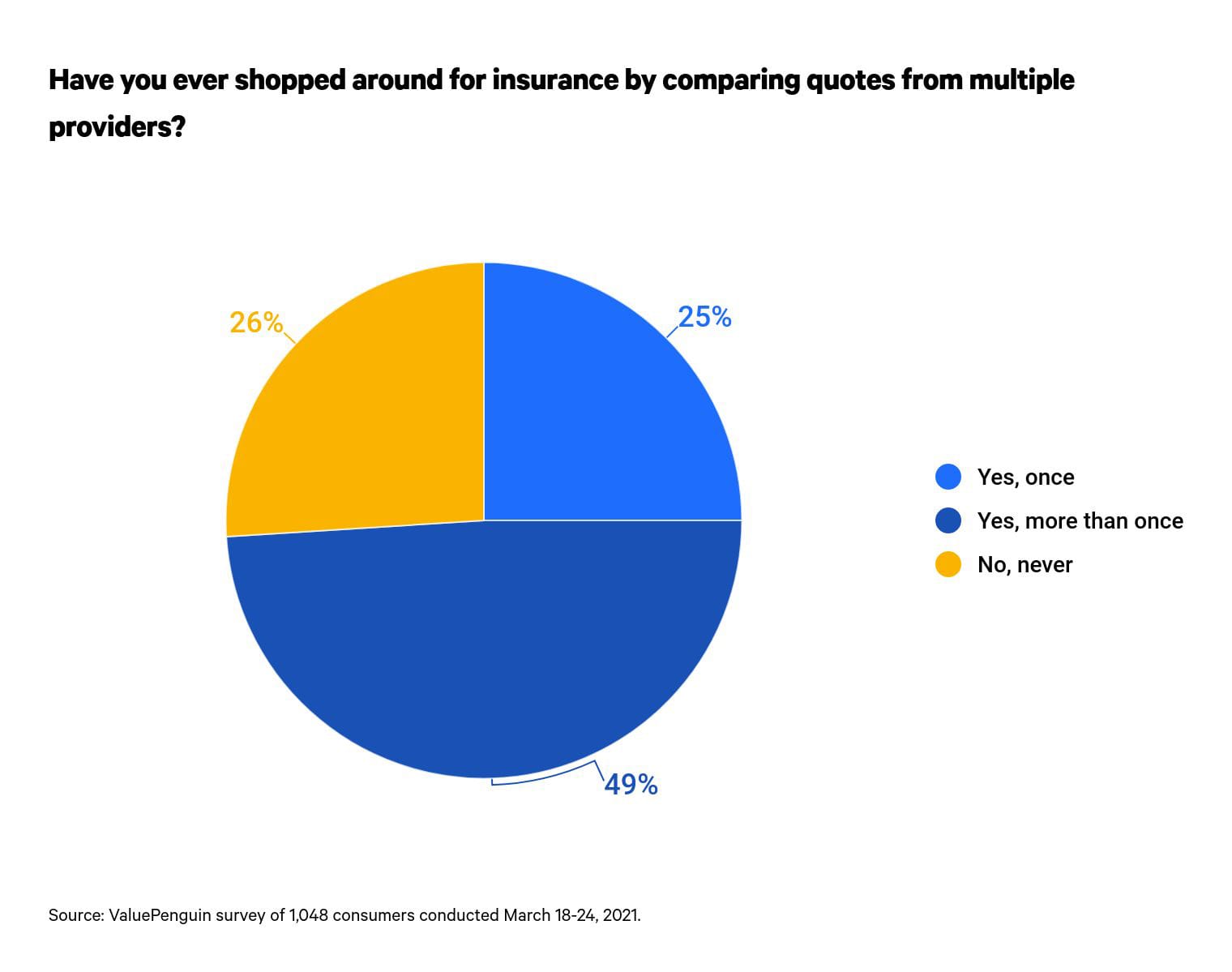
For some consumers, comparison shopping could mean getting their best rates on auto insurance. Others might end up overpaying because they didn’t shop around for homeowners insurance.
Shopping around proved to be important for many respondents. In fact, 76% of consumers who have shopped around saved money at least once.
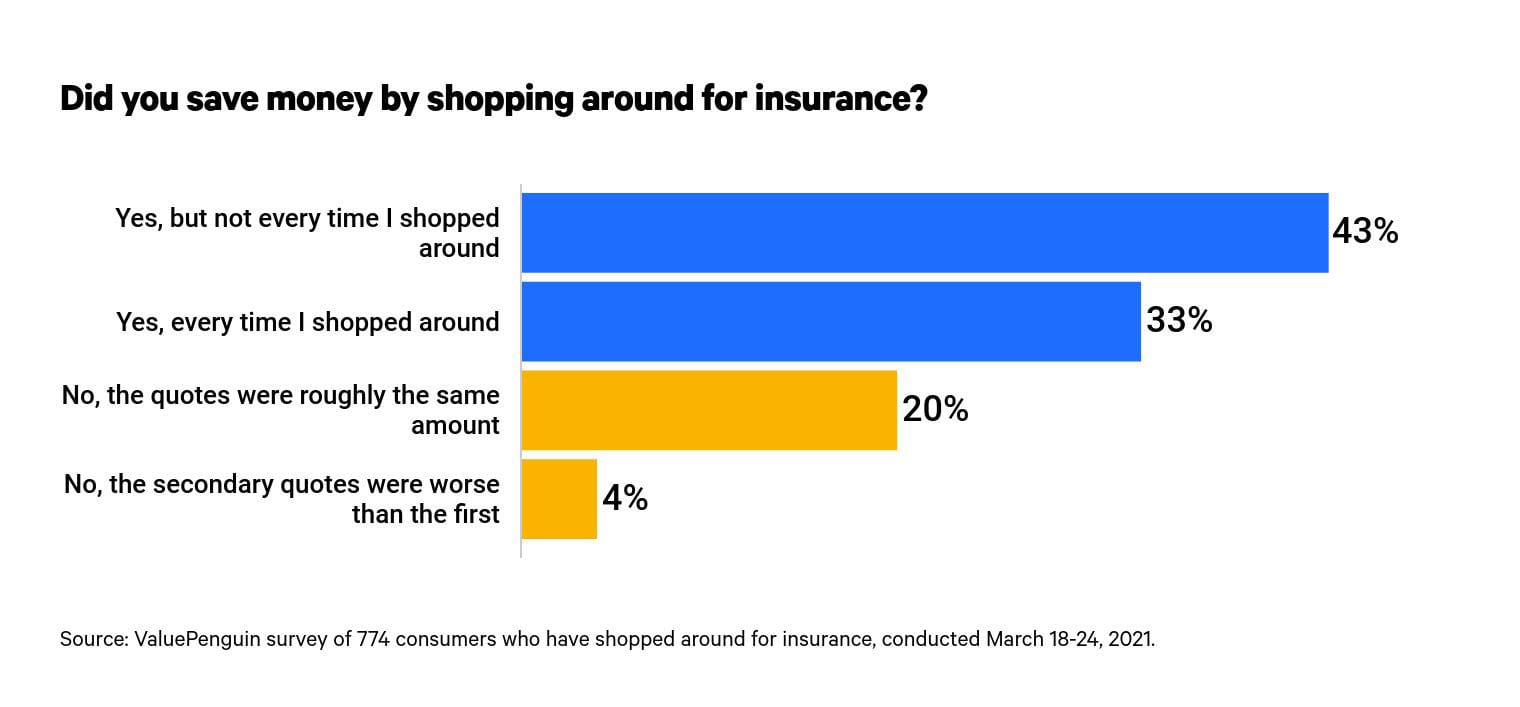
While more Americans (43%) report saving only some of the time compared to those who save every time (33%), it doesn’t hurt to explore multiple providers, regardless of the type of insurance.
How much money consumers save by shopping around — and how long it takes
Thirty percent of Americans who’ve shopped around say they’ve saved $500 or more during their lifetime when comparing rates. Among those who’ve shopped around, here’s what consumers say they’ve saved:
- Less than $100: 26%
- Between $100 and $499: 44%
- Between $500 and $999: 16%
- $1,000 or more: 14%
As it turns out, saving money might not take that much effort. Nearly half (47%) of Americans who shopped around say they spent less than an hour the last time they did. For nearly 1 in 5 (18%) Americans, it took longer than two hours.
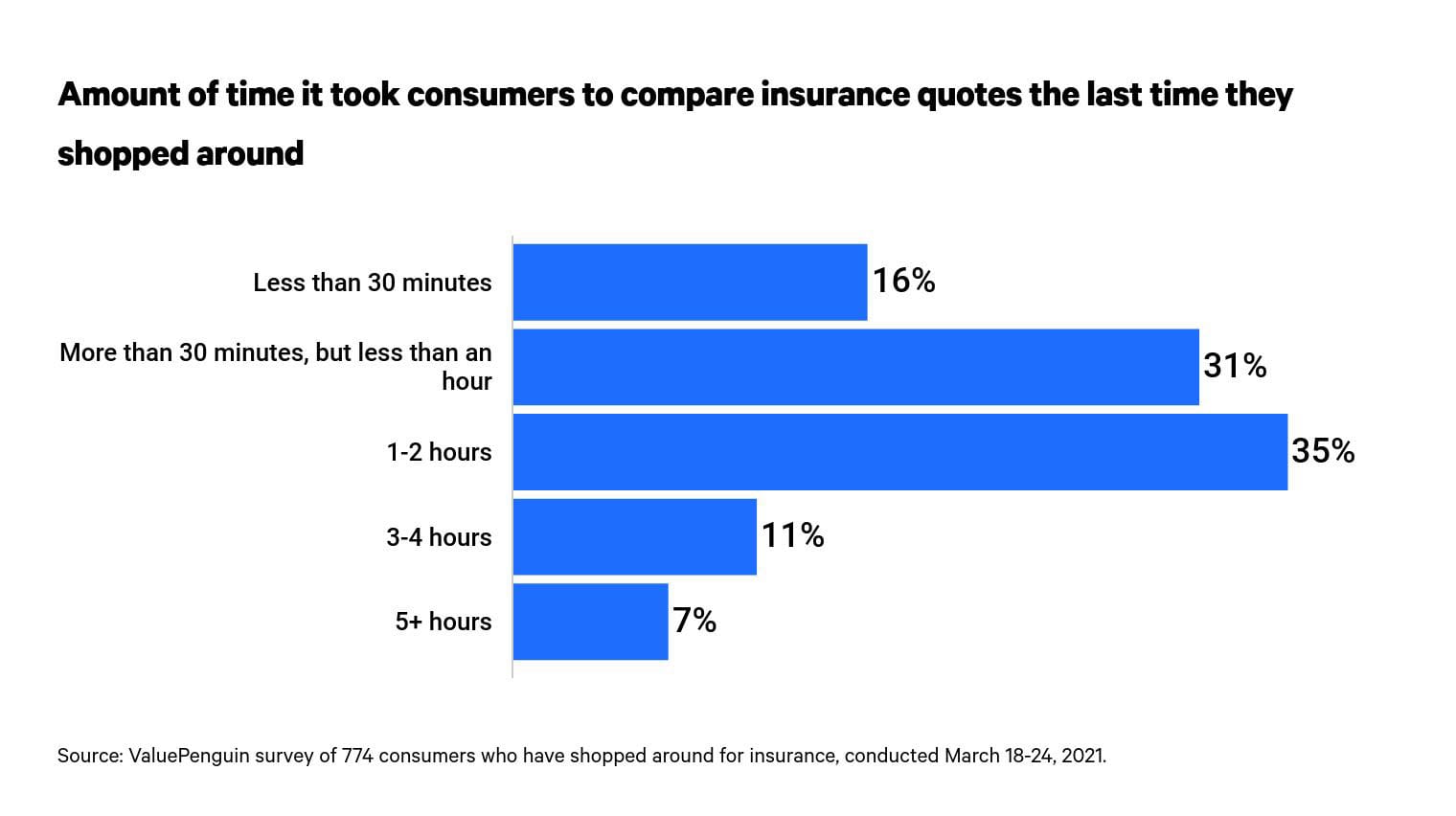
Thirty minutes to two hours should be a good amount of time to adequately compare plans and do deeper dives on various insurance companies, ValuePenguin insurance expert Sterling Price says.
"Spending this time will allow you to get a holistic view of the insurance market," he says. "You will begin to identify patterns in the premiums being offered, with some insurance companies preferring certain types of drivers and health profiles. In the end, it will be advantageous to choose the company that offers you the best and cheapest premium."
Why aren’t more consumers shopping around for insurance?
If time and energy aren’t the issues, why don’t all consumers take the time to see if they can save money? Call it brand loyalty.
It turns out, the largest percentage (43%) of consumers who haven’t shopped around are happy with their current provider or policy. Though the majority of respondents (75%) say they believe shopping around can save at least some money, it could be that those who haven’t shopped around aren’t buying the hype.
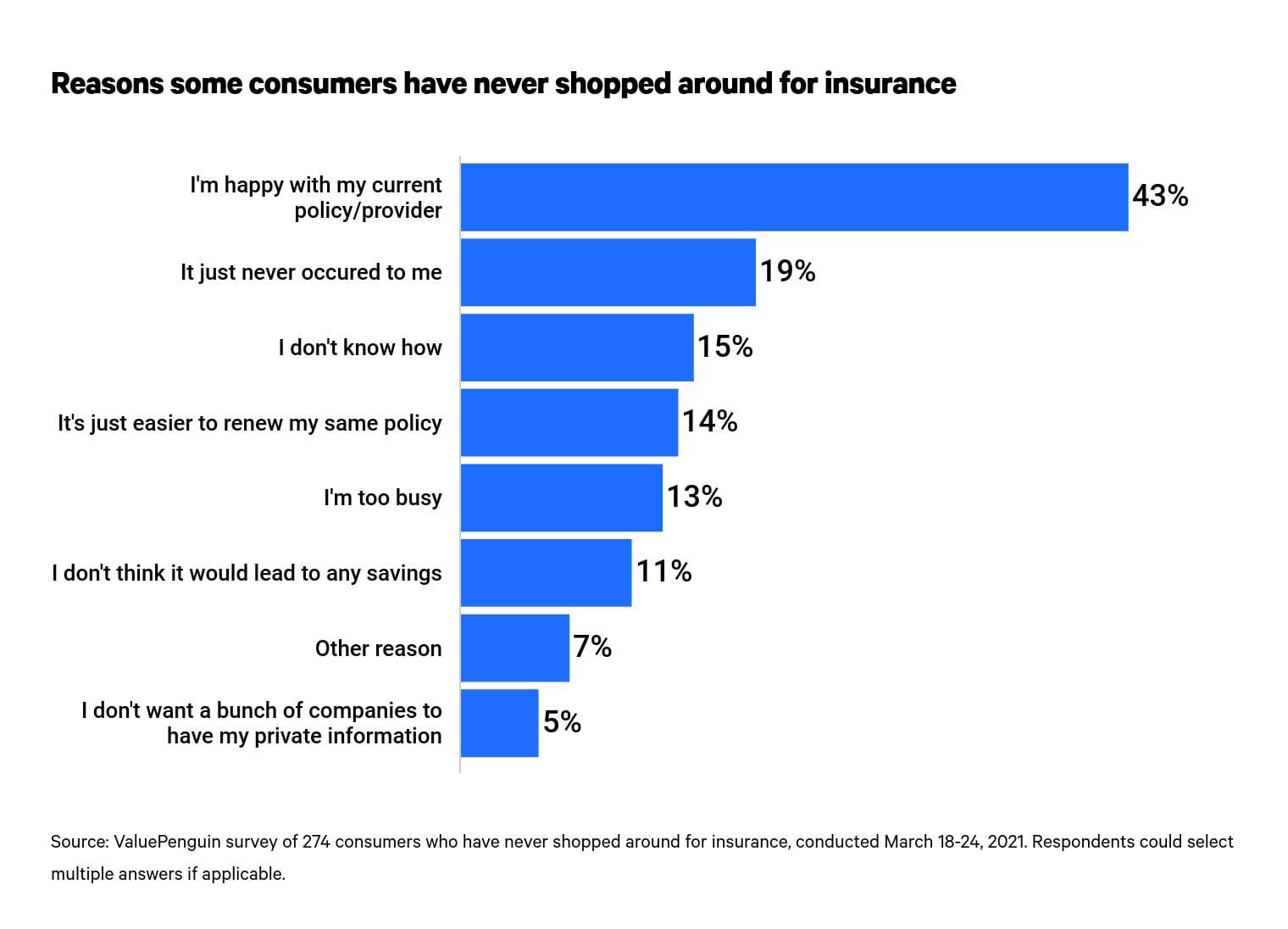
Interestingly, the 25% of Americans who say they don’t think shopping around can save money nearly mirrors the percentage of consumers (26%) who say they’ve never shopped around. It’s plausible that some Americans identify with both sentiments.
When Americans would be more willing to shop around for insurance
While 33% of Americans say they’d consider shopping around if they became unhappy with their current policy, the largest share of consumers say the unknown is stopping them, too.
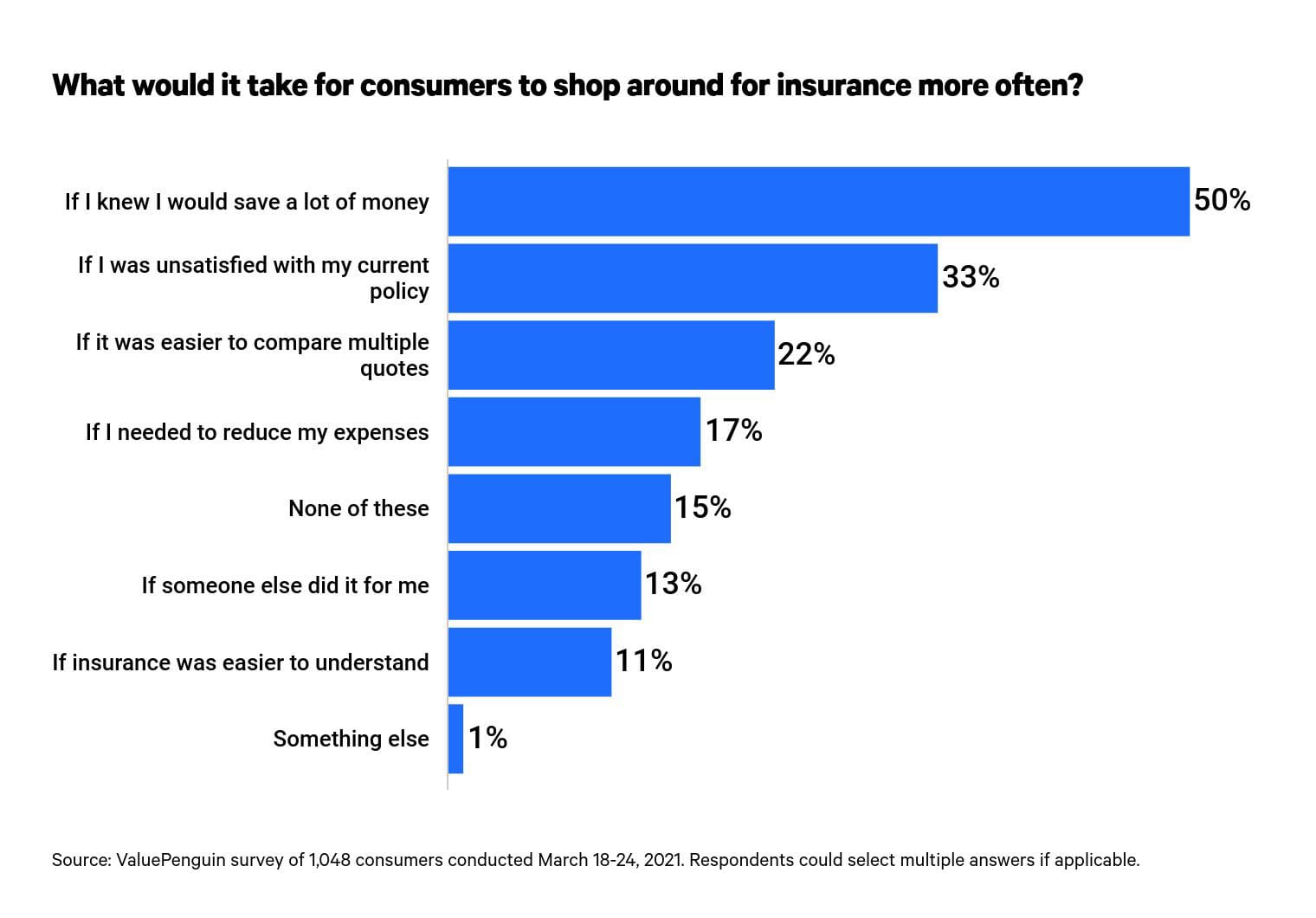
Half of policyholders say they would need to know that they would be saving a lot of money to be inspired to shop around more. But saving money is just one of the possible advantages of shopping around. Price quotes may not change each time, but the benefits could.
"Insurance providers may have extra benefits they offer to policyholders," Price says. This could impact policies from health insurance (getting a discount on a premium for participating in healthy activities) to auto insurance (getting safe driving benefits for not being in an accident).
Auto insurance (43%) is the top policy for which consumers would be most willing to compare prices, followed by:
- Health insurance: 14%
- Homeowners or renters insurance: 14%
- Life insurance: 9%
- Dental insurance: 3%
- Pet insurance: 2%
- Travel insurance: 2%
- Tech device insurance: 1%
Going further, auto insurance has the highest percentage of policyholders (31%) who shopped around and switched providers compared to homeowners or renters, pet or life insurance. In those categories, a quarter of policyholders report changing providers after shopping around.
Older consumers favor bundling insurance policies
Age appears to play a role when it comes to determining who’s bundling insurance policies. Baby boomers (ages 56 to 75) are nearly twice as likely as members of Generation Z (ages 18 to 24) to use the same insurance company for multiple policies.
More than half (55%) of all policyholders say they’ve bundled some of their policies with the same insurer, which has the potential of added savings.

"The biggest benefit of bundling insurance policies is the savings," Price says. "The most common bundle is combining home and auto insurance. But many people also don't consider the convenience aspect of bundling."
Consolidating bills and personal information with one company can add peace of mind when it comes to monthly premiums. On the other hand, bundling might discourage some consumers from periodically shopping around, meaning they may not get their best deal when it’s time for renewal.
"Once you have purchased a bundled policy, you will most likely just renew your policy year after year instead of shopping for the cheapest available," Price says. "It's harder to leave an insurer once you have bundled since you'll now have to look for two new insurance policies."
The bottom line is consumers shouldn’t stay content with their insurers if they’re looking for their best rates on insurance policies. Only 17% of respondents say needing to reduce expenses would encourage them to shop around, but perhaps they shouldn’t wait. Extra savings now could mean more cash to cover emergencies or go toward long-term investments.
Methodology
ValuePenguin commissioned Qualtrics to field an online survey of 1,048 Americans, conducted March 18-24, 2021. The survey was administered using a non-probability-based sample, and quotas were used to ensure the sample base represented the overall population. All responses were reviewed by researchers for quality control.
We defined generations as the following ages in 2021:
- Generation Z: 18 to 24
- Millennial: 25 to 40
- Generation X: 41 to 55
- Baby boomer: 56 to 75
While the survey also included consumers from the silent generation (defined as those 76 and older), the sample size was too small to include findings related to that group in the generational breakdowns.